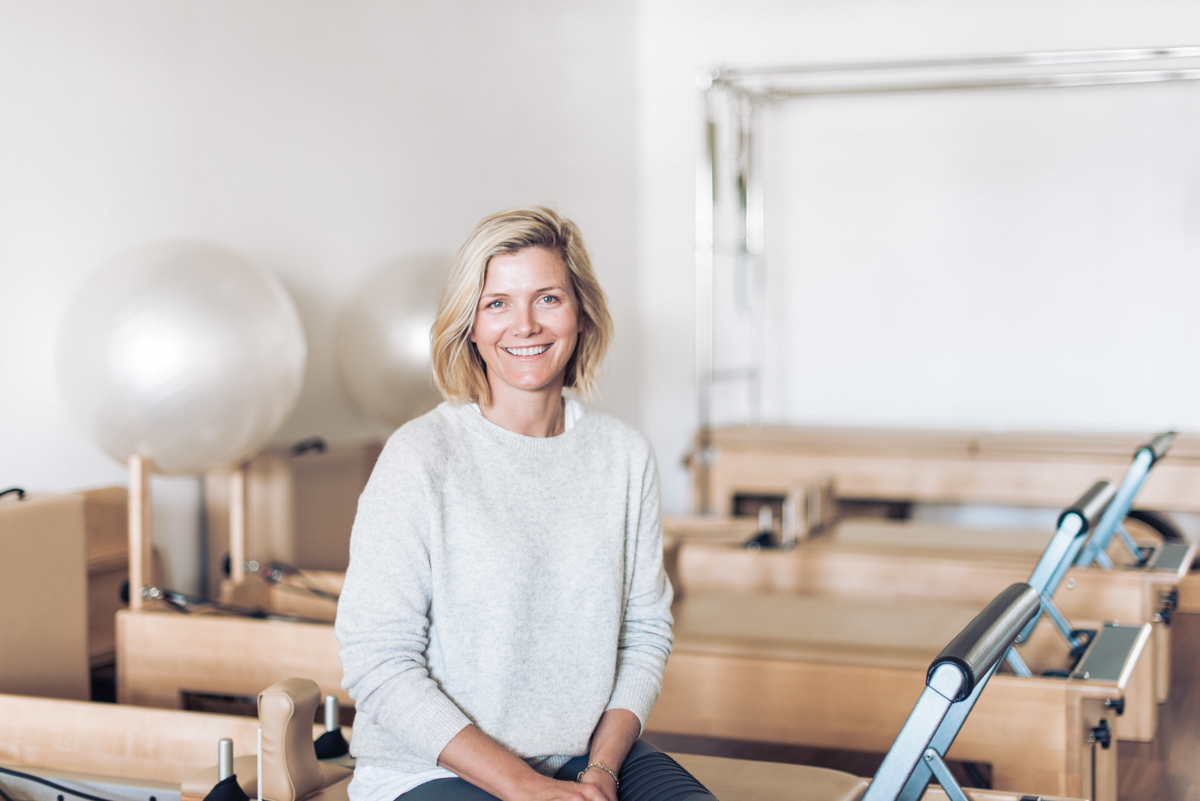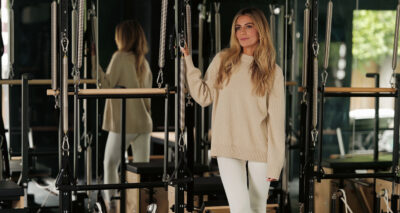Physical Therapist Allison Oswald's Tips for Mothers
Translation missing: en.blogs.article.author_on_date_html
Wellness
Physical Therapist Allison Oswald’s Tips for Mothers
May 20, 2017

Allison Oswald is a physical therapist who works with women to align, strengthen, and restore their bodies before, during, and after pregnancy. Allison has helped me tremendously and I find her work so interesting and important for mothers to know about. Pregnancy and labor do a number on our bodies, and many women suffer strains and injuries in silence because they are focused on their new babies or are embarrassed to speak up. Allison does incredible work helping women correct their posture, strengthen their pelvic floor and core, and understand their bodies better as they go through the process of creating and giving birth to a new little human. In short, she’s amazing!
We asked Allison a little bit about her practice and how women can stay healthy during each stage of pregnancy as a way to introduce you to her work. I hope you benefit from her expertise just as I did! XXJKE
Rip & Tan: How did you become a women’s health physical therapist? What led you to this career?
Allison Oswald: In my doctorate program at Mount Saint Mary’s, I took one Women’s Health course—but that one course was enough to spark my interest to begin my journey in achieving a board certification specialty after graduation. Since then I have consumed myself with courses, books, and as much experience as possible to continue to learn what I can offer to my clients.
I have always had a natural connection to women’s health, especially once I experienced my first pregnancy. Not that all Women’s Health is related to pregnancy, but it truly gave me a deeper connection to womanhood, the incredible bodies we have, and what we are capable of. In this day and age, we have learned through society a lot of misconceptions about what is normal and what is not about our bodies. Through experience, I’ve learned that much of what I and other Women’s Health PT’s do is completely new information to some. You’d be amazed by how many of my clients walk out acknowledging that their symptoms need not be hidden or thrown under the rug any longer. This makes it even more motivating to get the word out there, even if it means one client at a time.
Rip & Tan: What training have you undergone to practice this specific type of physical therapy?
AO: Once I became a Doctor of Physical Therapy, I began taking women’s health courses through our national association. Then in 2011, I took the National Board Certification for Women’s Health. As time goes on, I strive to continue to take any courses, workshops and learn as much as possible as research and treatment options constantly change. For example, I am also a certified Pilates teacher and massage therapist.
Rip & Tan: What schools of thought or philosophies do you subscribe to when it comes to women’s health?
AO: I take a truly holistic approach with women’s health. We are realizing more and more how our physical health is influenced by emotions, nutrition, activity levels and more. By addressing all of these components, I’m able to see my clients heal at a much deeper level.
Rip & Tan: What is your typical work day like? What types of problems do you treat and what are the other components of your job?
AO: I wake up by 5:30am so I can have a few moments to myself before anyone else is up in my family. I often sit and do some breath work, set my intentions for the day, and brew a pot of coffee. This routine helps me feel grounded and prepared for the day ahead. Once my husband and kids are up, I’m able to make them some breakfast and go over the schedule for the day before I’m at my office by 7am. After seeing patients all morning, I save a little time at the end of my day (2pm) for paperwork, correspondence, and communication with my Pilates instructors and team. Then I jet out of the office to pick up my kids from school and spend the rest of the afternoon with them. I would not be able to treat as many patients as I do and get everything done at the studio without my amazing assistant Linsey, she is my right hand (and sometimes right brain) for sure!
Rip & Tan: Tell us about yourself personally! Where do you live and what do you do in your free time?
AO: I am lucky enough to live in beautiful Santa Monica, CA with my husband of 9 years and two young boys Vincent (5 years old) and Will (4 years old). We are an active family, so we love to hike, go on bike rides, and since we live only a few minutes away from the beach, a beach day never disappoints! I also really enjoy cooking, so I spend time at the farmer’s markets getting the best food I can find to make delicious, healthy food for my family and friends. And when I need a break from cooking, a night out with some girlfriends at our favorite restaurants can do the trick!
PREGANCY TIPS
Rip & Tan: Please share 3-5 tips for each trimester of pregnancy as well as for women who are trying to conceive, and women who are in the postpartum period!
Trying to Conceive
Detox Now: Most women jump on the “health” bandwagon once they discover they are pregnant, but in reality, it is well before this point that women should be caring for their bodies. Setting good habits with nutrition and exercise will help you maintain it once you do conceive. I recommend a light yet nourished detox coordinated with your doctor or health coach to get the body as healthy and clean as possible.
Eat for Health: This is probably the most important period of time to care for your self in regards to nutrition and exercise. In order to conceive you want to be eating a balanced diet (organic, whole foods), exercising regularly and manage stress as much as possible. This looks different for everyone, but find what works best for you.
Get Your Body Ready: Connect to your pelvic floor and get to know how it works. This could be through your own research or seeing a women’s health practitioner to explain the anatomy and function. Connecting your brain to how your body works (specifically your pelvic floor) is very empowering and especially beneficial once you become pregnant as well as during labor/delivery. Also, stay away from toxic cleaning/cosmetic products, which have been found to be endocrine disrupters.
First Trimester
Use Your Intuition: There is a lot happening in the first trimester, so many hormonal changes that even though you might not be able to visually see changes in your body yet, you will most definitely feel them. Give yourself a break, rest as much as you need, and even though exercise is so important, be gentle with yourself and listen to what you body needs.
Posture Up: All of our bodies function best in what is referred to as “neutral spine”. This is different for each individual, but it is the position that allows us to access our core system (including your pelvic floor) most efficiently. Any woman would benefit from reviewing this posture with a women’s health PT (in standing, sitting, and with function) so she can maintain it as best as possible. It will be altered as her center of mass changes, but can be adapted as she progresses in her pregnancy.
With the surge in hormones, I commonly have women with achy low backs. Sitting on an exercise ball and doing hip circles is a great way to release that tension. Do 10 each direction, breathing continuously.
Stay Strong: Begin a breathing practice as it relates to your pelvic floor. Sit daily in a comfortable position. Practice inhaling through your nose as your rib cage expands laterally, visualizing your pelvic floor lengthening down. Exhale through your mouth as the ribcage comes back in and the pelvic floor naturally recoils back up. There is no need to do an active pelvic floor contraction (kegel) unless you are having pelvic floor symptoms (ie. leaking) and have been assessed by a women’s health physical therapist.
Second Trimester
Realign in Real Time: For many women this is the time that your belly has finally “popped”. Unfortunately, this is also the time that women change their posture to make it seem like they are more pregnant. Sometimes this can look like letting your belly go (overly arching your low back) which can actually cause more stress on your joints, tightness in your back and poor function of your core system.
To combat this, practice better alignment throughout your day and with exercise. This means keeping weight equally distributed between both feet, not locking out your knees, and stacking your spine as best you can without tucking your butt underneath you. No one can or needs to do this 100% of the day, but if you are aware of it and can correct yourself when you fall out of it, you’re on the right track.
Buy for Your Body: This might be the time you are picking out your baby items/registry. Be sure you consider your own body mechanics when doing so. For example, if you’re tall, getting a taller changing table so you don’t have to bend down as much. Or, if you have back problems, choosing a lighter car seat.
Third Trimester
Stay Active: Once women get closer to delivery they often feel like they can’t do as much physically, but that is not always true. In the last 4-6 weeks of gestation I always recommend mothers to continue to be active or at least modify their exercise regime. Even if this means going for more walks, taking a restorative yoga class or practicing Pilates with instructors who are aware of pregnancy modifications – this time should empower women to take care of their mind/body physically and emotionally before the arrival of their little one.
I particularly recommend women begin practicing a deep squat position to gently open up the pelvis and pelvic floor to prepare for labor. In yoga this is referred to as the Malasana squat. You would squat down on some sort of support (yoga block, bolster, stool) with the legs open wide. Make sure you maintain a slight arch in your low back and then lean forward to place your elbows between your knees. Keep your chest lifted and breath here, visualizing your pelvic floor lengthening with each breath. You can hold this for a few minutes or what seems comfortable for your body.
Prepare for Labor: I also recommend women begin doing perineal massage in the last few weeks of pregnancy, if cleared by their OBGYN or midwife. This prepares the perineum for delivery, increasing flexibility and decreasing perineal trauma during delivery. You can do this yourself or have your partner help, but the simplified explanation is: Find a comfortable slightly reclined position, use a non-irritating oil on the perineum (tissue between your vagina and anus), using your thumbs gently press down on the perineum towards the anus through outer edge of the vagina. Hold this pressure for a few minutes, to feel stretch not pain. Then gently swipe towards the sides, you can hold pressure here as well, along with continued swiping from the bottom out. Do this for 5-10 minutes daily.
Postpartum
Focus on Healing: In the immediate postpartum period, I am huge advocate for holding that time and space sacred for the mother and the baby. Physically and emotionally it is a crucial time for bonding and healing. Unfortunately, in our culture it can sometimes be celebrated by how a woman’s body bounces back, how quickly she is out and about with the baby and is back to her regular routine. But I believe that shouldn’t be the goal, a woman should give herself time, ask for help and heal from the inside out.
Breathe Deep: During this sacred time, women can be mindful of their alignment and posture to allow their pelvic floor and abdominal walls to heal properly. Beginning to incorporate a breathing practice to connect to the pelvic floor will improve circulation and therefore healing.
Exhale with exertion. If you are in the correct alignment (neutral spine), the pelvic floor contracts while you exhale. By simply exhaling as you lift or get up from the floor, you are turning on your core system a bit more to give you the support you need.
Baby Your Belly: It is now reported that 100% of women get diastasis recti during pregnancy, most of which heal properly postpartum, but some do not. In order to promote proper healing, you should roll to your side to get in/out of bed to avoid a strain to your abdominal wall. This should be done for the first 12 weeks postpartum, and more if you have been tested positive for diastasis recti.









